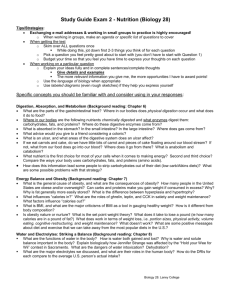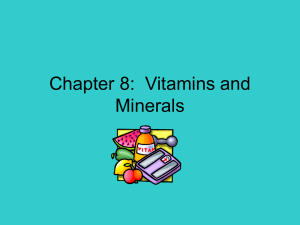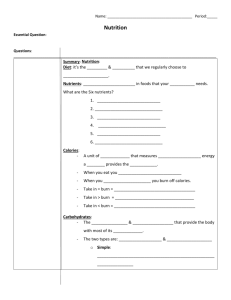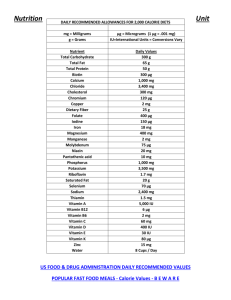St review final exam
advertisement
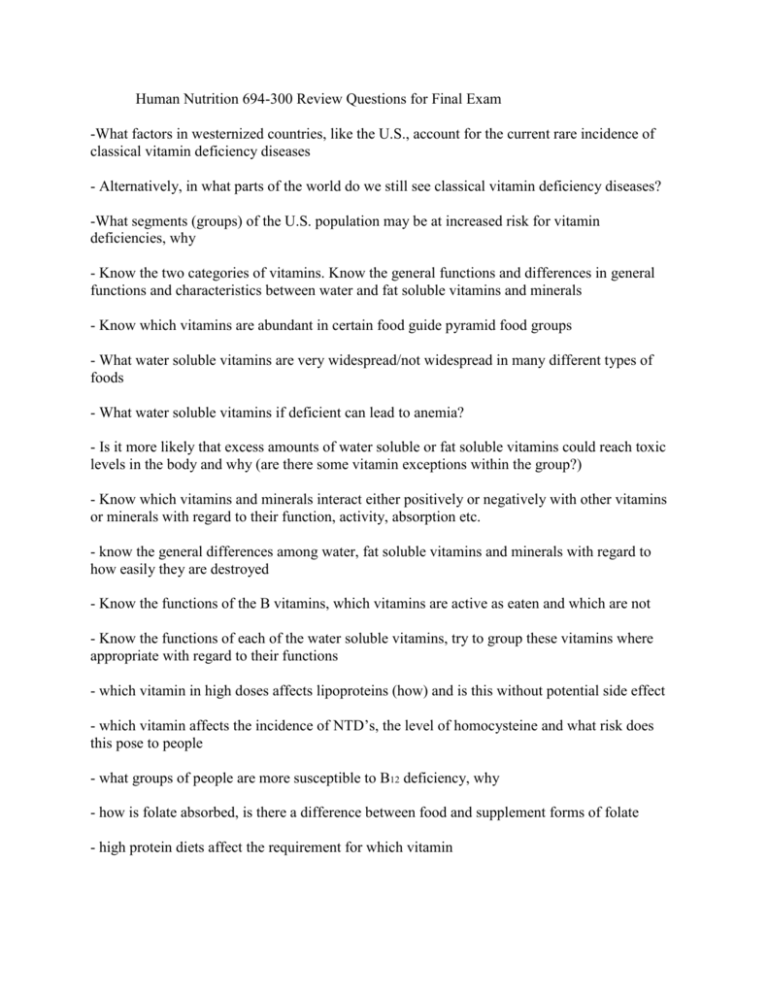
Human Nutrition 694-300 Review Questions for Final Exam -What factors in westernized countries, like the U.S., account for the current rare incidence of classical vitamin deficiency diseases - Alternatively, in what parts of the world do we still see classical vitamin deficiency diseases? -What segments (groups) of the U.S. population may be at increased risk for vitamin deficiencies, why - Know the two categories of vitamins. Know the general functions and differences in general functions and characteristics between water and fat soluble vitamins and minerals - Know which vitamins are abundant in certain food guide pyramid food groups - What water soluble vitamins are very widespread/not widespread in many different types of foods - What water soluble vitamins if deficient can lead to anemia? - Is it more likely that excess amounts of water soluble or fat soluble vitamins could reach toxic levels in the body and why (are there some vitamin exceptions within the group?) - Know which vitamins and minerals interact either positively or negatively with other vitamins or minerals with regard to their function, activity, absorption etc. - know the general differences among water, fat soluble vitamins and minerals with regard to how easily they are destroyed - Know the functions of the B vitamins, which vitamins are active as eaten and which are not - Know the functions of each of the water soluble vitamins, try to group these vitamins where appropriate with regard to their functions - which vitamin in high doses affects lipoproteins (how) and is this without potential side effect - which vitamin affects the incidence of NTD’s, the level of homocysteine and what risk does this pose to people - what groups of people are more susceptible to B12 deficiency, why - how is folate absorbed, is there a difference between food and supplement forms of folate - high protein diets affect the requirement for which vitamin - Which water soluble vitamin is an antioxidant? Is there any group of people that may need a slightly higher level of this vitamin because of particular habits and why? - which vitamins are particularly antagonized by excess alcohol intake - Know good food sources for each of the four fat soluble vitamins and -carotene. - know the functions, deficiency symptoms of the fat soluble vitamins -know which of the fat-soluble vitamins are quite toxic in excess and which of the fatsoluble vitamins are rarely toxic, why. - understand that vitamin A is actually a family of three forms of vitamin A, retinol, retinal, and retinoic acid. Know the roles of each of these in the body. Are they all interconvertible? Is there any other vitamin that affects the interconversion of these forms of vitamin A. - understand that b-carotene can be converted to vitamin A in the body. Can a person get a vitamin A toxicity from overconsumption of b-carotene and why/why not? - What are the inactive/less active and active forms of vitamin D what is the precursor of D in the skin and what is the basic role of sunlight, liver and kidney for full D activity. A person with kidney or liver disease might they have D deficiency, why? Understand the function of D on the intestines, kidneys, bones - What lifestyle, cultural, geographical situations could contribute to a D deficiency? - Understand the general function of vitamin E (antioxidant) and diseases that are affected by E - Which vitamins are made by intestinal bacteria? Would antibiotics cause a potential deficiency? - What is the function of vitamin K, Why are newborns potentially deficient in this vitamin? - It will help to group the functions of the various minerals, i.e., those that affect bone (Ca, P, vitamin D), those that are important electrolytes inside and outside of cells, blood volume, blood pressure (Na+, Cl-, K+, Ca++, Mg++), those with an antioxidant function - know those minerals whose absorption is clearly regulated, that is where the absorption % varies significantly depending on the status of the body - know those minerals that are often inadequate in the US diet and those that are often in excess - particularly know how the relative amounts of certain mineral pairs affect health and physiology (Ca++:Na+, Ca++: Protein, Ca++: P, Na+: K+) - Understand the various functions of calcium and how the body prioritizes these functions. If the diet isn't supplying enough calcium to meet all its functions, what happens? - When dealing with calcium a basic understanding of the role of parathormone and calcitonin is required. How do these two hormones work to control blood levels of calcium? -Understand what factors influence absorption of calcium, and development of osteoporosis - What does peak bone mass refer to and when does it occur? - Na, K+ and Cl- know their functions. What situations may precipitate a deficiency in these minerals, what is their effect on blood pressure? -Understand the interaction between Na+ and K+, what categories of foods each is relatively abundant in, their roles in blood pressure maintenance. - Does Mg++ have any effect in heart disease, blood pressure? - For trace minerals know mineral interactions as mentioned before. - know the functions of Fe. - Do we primarily control the level of Fe through absorption or excretion. - understand what two minerals must be keep bound to proteins and not let free - What are the two food forms of Fe and how are they different in terms of absorption - What factors affect the absorption of Fe? - Is Fe deficiency anemia the first sign of Fe deficiency? - Is too much Fe a problem, what major disease is excess Fe linked to? - Know the functions of Zn. - What are the physiological functions of water? - What are the health differences between hard and soft water? What factors trigger hunger? How do hunger, appetite interact. What factors affect satiety - Understand the 4 categories of thermogenesis, what basal thermogenesis is and what affects BMR. - What was the historical definition of overweight and what was faulty about this definition? What factors determine healthy versus unhealthy weight, understand body composition, distribution of body fat, weight to frame size, body mass index What disease are affected by obesity, distinguish between those that are genetically linked and those that are not, what health problems are affected by underweight What does fitness refer to. What is physical conditioning, overload. What are physiological responses to overload. What fuels are used for exercise, what determines what % of fuel is used



